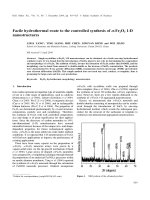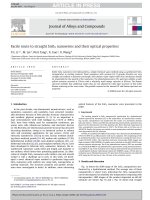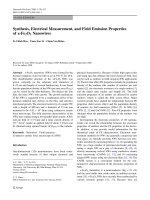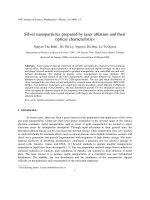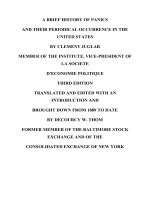Controlled synthesis of nanostructures and their optical properties
Bạn đang xem bản rút gọn của tài liệu. Xem và tải ngay bản đầy đủ của tài liệu tại đây (1.43 MB, 82 trang )
CONTROLLED SYNTHESIS OF NANOSTRUCTURES
AND THEIR OPTICAL PROPERTIES
KHOH RONG LUN
(B.Sc.(Hons.), NUS)
A THESIS SUBMITTED
FOR THE DEGREE OF MASTER OF SCIENCE
DEPARTMENT OF CHEMISTRY
NATIONAL UNIVERSITY OF SINGAPORE
2011
Acknowledgement
I would like to express my gratitude to the many people who have made this
thesis possible.
The first person I would like to thank would be my supervisor, Associate
Professor Chin Wee Shong. It had been a fruitful period spent with her from my
Honours year to the end of my M.Sc. course. She had been an exemplary mentor who
was patient, genuine and generous with her support. I am grateful for the many
opportunities she had provided me, from having the chance to mentor junior Honours
students to participating in conferences both in Singapore and Malaysia. Also, she
was always encouraging of new ideas and that made my days spent in lab particularly
rewarding. I would look forward to having discussions with her for she would always
provide good suggestions and impress me with her professionalism.
I would like to thank Professor Andrew Wee and Associate Professor Thorsten
Wohland for being my referees, without whom I would not be able to defer my MOE
bond fulfilment and embark on my graduate studies.
My fellow group members included: Dr. Xu Hairuo, Dr. Neo Min Shern, Dr.
Li Guoshuo, Madam Liang Eping, Ms. Teo Tingting Sharon, Ms. Loh Pui Yee, Ms.
Tan Zhi Yi and Mr. Huang Baoshi Barry. It was with their immense support and
active contribution in ideas that helped made the course enjoyable. In particular, I
would like to thank Dr. Xu Hairuo, who was also mentor for my Honours project, for
leaving me with such good experience with research that I was encouraged to pursue a
i
research-based higher degree. In addition, I would like to thank the support and
laboratory staff from Department of Chemistry, Department of Biological Sciences
and Department of Material Engineering for being big-hearted and helpful. It was
with their help that facilitated the resolving of administrative issues and
characterization of samples.
Furthermore, I would like to thank my peers for being such pillars of support.
They included friends from NUS Students’ Science Club, Ms. Chen Shuhui, Mr. Chan
Xin Wei, Mr. Andy Chia, Mr. Lee Wei Kit, Mr. Wang Wei Yang, Mr. Nai Chang Tai
and Ms. Chan Zi Ping. In particular, it had been an awesome experience mentoring
Ms. Chen Shuhui and Mr. Chan Xin Wei.
Finally, I would like to thank my parents Mr. Khoh Kian Hock and Mdm
Chiang Swee Lan for being forever tolerant and supportive of my decisions and
actions.
ii
Table of Contents
Summary ……………………………………………………………………….
vii
List of Publications ……………………………………………………………
ix
List of Figures …………………………………………………………………
x
List of Tables …………………………………………………………………
xii
Chapter 1
Introduction
1
1.1
Background ………………………………………………………
1
1.2
Size-dependent Properties: The Effect and Control of Sizes …….
2
1.2.1
Semiconductor Nanocrystals …………………………….
2
1.2.2
Metal Nanocrystals ………………………………………
4
1.3
Shape-dependent Properties: The Effect and Control of Shapes ...
5
1.4
Multi-component Nanocrystals .....................................................
7
1.4.1
Doped Nanocrystals ……………………………………...
8
1.4.2
Heterostructured Nanocrystals …………………………...
9
1.4.3
Hybrid Nanocrystals ……………………………………..
12
Synthetic Methodologies of Nanocrystals ……………………….
13
1.5.1
Solution Synthesis of Nanocrystals ………………………
15
1.5.2
Synthesis of Doped Nanocrystals ………………………...
16
1.5.3
Synthesis of Heterostructured and Hybrid Nanocrystals …
17
Objective and Scope of the Thesis ………………………………..
18
1.5
1.6
iii
1.7
Chapter 2
References ………………….………………………………..........
19
Experimental
24
2.1
Chemical reagents ………………………………………………… 24
2.2
Preparation procedures ……………………………………………
25
2.2.1
Preparation of CdS|CdSe|CdS nanorods ………………….
25
2.2.2
Preparation of CdSe|CdS|CdSe nanorods ………………...
26
2.2.3
Preparation of gold-deposited CdS|CdSe|CdS and
CdSe|CdS|CdSe nanorods ………………………………...
2.2.4
2.3
26
Preparation of cadmium thiobenzoate and zinc
thiobenzoate precursors …………………………………...
27
2.2.5
Preparation of CdS quantum dots ………………………. .
28
2.2.6
Preparation of CdS-seeded Mn2+-doped ZnS …………….
28
2.2.7
Preparation of gold-decorated CdS-seeded Mn2+-doped
ZnS …….………………………………………………...
29
Characterization Techniques …………………………………….
29
2.3.1
Transmission Electron Microscopy and High Resolution
Transmission Electron Microscopy ……………………..
29
2.3.2
Ultraviolet-visible Absorption Spectroscopy …………...
30
2.3.3
Steady-state Photoluminescence Spectroscopy …………
30
2.3.4
Elemental Analysis ……………………………………...
31
2.3.5
Thermal Gravimetric Analysis ………………………….
31
2.3.6
Powder X-Ray Diffraction ……………………………..
32
iv
2.4
Chapter 3
References ………………….………………………………..........
Gold Deposition on CdSe|CdS Heterostructured Sandwiched
Nanorods
3.1
38
Deposition of Au on the CdS|CdSe|CdS and CdSe|CdS|CdSe
sandwiched nanorods ……………….……………………………
3.4
34
Optical properties of the CdS|CdSe|CdS and CdSe|CdS|CdSe
sandwiched nanorods ……………….…………………………….
3.3
33
Synthesis and characterization of the CdS|CdSe|CdS and
CdSe|CdS|CdSe sandwiched nanorods …………………………...
3.2
32
41
Optical properties of the Au-deposited CdS|CdSe|CdS and
CdSe|CdS|CdSe sandwiched nanorods ………………………….
46
3.5
Summary ………………………………………………….....…...
49
3.6
References ……………………………………………….............
49
Chapter 4
Gold Deposition on CdS/ZnS:Mn2+ Doped-and-Seeded
Heterostructured Nanocrystals
51
4.1
Synthesis and characterization of the CdS seeds …………….….
52
4.2
Synthesis and characterization of the CdS/ZnS seeded
nanorods …………………………….…………………………...
4.3
4.4
55
Synthesis and characterization of the CdS/ZnS:Mn2+ doped-and-seeded
nanorods …………………………….…………………………...
59
Gold deposition on the CdS/ZnS:Mn2+ hybrid nanorods ………..
62
v
4.5
Summary …………………………………………………............
64
4.6
References ……………………………………………….............
65
Chapter 5
Conclusions and Outlook ………………………………………
67
vi
Summary
Summary
The ability to synthesize nanocrystals with good control over their sizes and
shapes had been a milestone for nanoscience. Works in the early days of nanoscience
were focused on understanding the underlying factors that affect sizes and shapes.
That had been done with much success, judging from the overwhelming number of
literatures that dealt with such discussions. A few parameters were subsequently
identified: monomer concentration, reaction temperature, choice of capping agents
and method of synthesis. The manipulation of these parameters then became a
cornerstone in achieving nanocrystals of a myriad of morphologies. Despite the
apparent success the control over engineering of nanocrystals, there has been much
lesser understanding towards the underlying principles behind the outcomes of some
syntheses. This issue became more acute as research progressed to investigate multicomponent nanocrystals where different materials of various shapes and sizes were
combined.
The focus of the works in this thesis was on the issues of synthesis and optical
properties of multi-component nanocrystals comprising metal sulfide/selenide
nanorods. In Chapter 3, we had successfully synthesized the sandwich CdS|CdSe|CdS
and CdSe|CdS|CdSe nanorods and followed by the deposition of gold nanoparticles
onto system. Besides obtaining insights to the deposition behaviours of the gold
nanoparticles, we also observed interesting optical properties of the overall
nanoparticle system. We observed the gold deposition first occurred randomly along
vii
Summary
the sides of the nanorods due to defect growths, but the gold nanoparticles eventually
grew larger at the tips of nanorods because of Ostwald ripening.
In Chapter 4, we tapped on prior know-how of our research group to
synthesize a series of multi-component nanocrystals using rational stepwise synthesis
processes. We followed the optical properties of the nanoparticles systematically
while components were added one-by-one. In particular, we presented a case study
which involved the simultaneous presence of two potential quenchers, i.e. gold
nanoparticles and Mn2+ dopants. We observed that gold nanoparticles were better
quenchers than the Mn2+ dopants, in affecting the band gap emission of the seeded
semiconductor nanocrystals.
viii
List of Publications
Syntheses and Optical Properties of Multi-Component Hybrid Heterostructured
Nanoparticles
R. L. Khoh, S. Chen, W. S. Chin manuscript in preparation.
Preferred Gold Deposition Sites on Heterostructured Sandwiched Nanorods and
the Consequential Changes in Optical Properties
R. L. Khoh, X. W. Chan, W. S. Chin manuscript in preparation.
ix
List of Figures
List of Figures
1.1
A plot for illustrating nucleation and growth during the preparation of 14
nanoparticles.
3.1
Cartoon illustrations of (a) ABA and (b) BAB nanorods, where A denotes 35
CdS and B denotes CdSe.
3.2
TEM images of CdS|CdSe|CdS and CdSe|CdS|CdSe nanorods.
3.3
XRD patterns of CdS|CdSe|CdS and CdSe|CdS|CdSe nanorods and 36
schematic illustration of the wurtzite crystal structure.
3.4
Chemical structures of (a) trioctylphosphine oxide and (b) 1- 37
tetradecylphosphonic acid.
3.5
HRTEM images of CdS|CdSe|CdS and CdSe|CdS|CdSe nanorods.
3.6
UV-Vis spectra of (a) pure CdSe, (b) pure CdS and (c) a 1:1 physical 39
mixture of CdS and CdSe nanorods.
3.7
PL spectra of (a) CdS, (b) CdSe and (c) a 1:1 physical mixture of CdS and 39
CdSe nanorods.
3.8
(a) & (c) UV-Vis and (b) & (d) PL (λexcitation = 525 nm) spectra of the 40
CdS|CdSe|CdS (top, purple) and CdSe|CdS|CdSe (bottom, red)
sandwiched nanorods respectively.
3.9
Possible morphologies for Au deposition on the CdS|CdSe|CdS structure: 42
(a) Au deposited randomly along the nanorod, (b) Auselectively deposited
on the tips of the nanorod and (c) Au selectively deposited on the lower
band gap (CdSe) segment of the nanorod.
35
38
3.10 TEM images of Au deposition on the ABA nanorods at (a) 10 min, (b) 30 43
min and (c) 60 min after injection of Au precursor.
3.11 Distribution histograms relating the number of Au nanoparticles deposited 44
on the various positions along the CdS|CdSe|CdS nanorod at (a) 10 min,
(b) 30 min and (c) 60 min after injection of Au precursor.
3.12 TEM image of Au deposition on the CdSe|CdS|CdSe nanorods 60 min 45
after injection of Au precursor.
x
List of Figures
3.13 (a) & (c) UV-Vis and (b) & (d) PL spectra of Au-deposited 47
CdS|CdSe|CdS (top) and CdSe|CdS|CdSe (bottom) nanorods at 10 min
(red), 30 min (green), 45 min (blue) and 60 min (pink) after injection of
the gold-precursor.
3.14 Temporal evolution of (a) & (c) UV-Vis and (b) & (d) PL spectra of Au 48
deposition on the CdS|CdSe|CdS (top) and CdSe|CdS|CdSe
(bottom)nanorods monitored at three- and six-minute intervals
respectively.
4.1
TGA curve for the decomposition of CdTB precursor from room 53
temperature to 600 ºC.
4.2
(a) UV-Vis absorption (red line) and PL (black line) spectrum of the CdS 54
seeds prepared. (b) XRD pattern of the CdS seeds fitted to the zinc blende
standard JCPDS 10-0454.
4.3
(a) Representative HRTEM image of the seeded CdS/ZnS nanorods 57
prepared. (b) UV-Vis absorption (red line) and PL (black line) spectrum
of the CdS-seeded ZnS nanorods. (c) Cartoon illustrating the change in
wave function as the ZnS nanorod was overgrown on the CdS seeds. (d)
XRD patterns of the CdS/ZnS nanorods prepared fitted to JCPDS: 050566. (e) Representative TEM image of the CdS/ZnS prepared.
4.4
(a) Representative TEM image of the CdS-seeded Mn2+-doped ZnS 60
nanorods, CdS/ZnS:Mn2+. (b) UV-Vis absorption (red line) and PL
emission (black line) spectrum of the CdS/ZnS:Mn2+ nanorods,
CdS/ZnS:Mn2+.
4.5
Schematics showing energy transfer from ZnS host and CdS to Mn2+ 62
dopants.
4.6
(a) Representative TEM image of Au decorated nanorods, Au- 64
CdS/ZnS:Mn2+. (b) PL spectrum of CdS/ZnS:Mn2+ (black) and AuCdS/ZnS:Mn2+ (red).
xi
List of Tables
List of Tables
1.1
Different morphologies of heterostructured nanocrystals.
10
1.2
Different types of semiconductor-semiconductor nanocrystals illustrated 11
using concentric core/shell nanocrystals.
2.1
Chemicals and solvents used and their respective percentage purities and 24
sources.
3.1
Average diameter of Au nanoparticles on both the side facets and tips of 43
the CdS|CdSe|CdS nanorod at 10 min, 30 min and 60 min intervals after
injection of Au precursor.
xii
Chapter 1
Chapter 1
Introduction
1.1
Background
Nanomaterials have attracted the interests of scientists and engineers alike for
nearly three decades and there is no sign for the level of interest to be abating. What
then has fuelled this immense interest? Firstly, nanomaterials display different
properties compared to their bulk counterparts. Besides the excitement to account for
the differences from the viewpoint of fundamental science, having different properties
also suggests that we can expand the range of applications of these materials from
what we already knew of the bulk materials. This could be exemplified by the lightemitting diodes made of CdSe nanocrystals.1 Whereas the bulk CdSe was known to be
monochromic, CdSe nanocrystals could be made to emit in the range of red to yellow.
Secondly, the nanometer size of particles allowed them to be useful in areas such as in
biological systems2,3 where the bigger particles were not.
As such, there had been a strong research buzz over the different aspects of
nanomaterials, most notably in areas involving the control and manipulation over their
growth, sizes, and shapes – all of which would determine their properties, applications
and performances. At the infancy stage of nanomaterials research, majority of work
dealt with single-material nanocrystals. Two most commonly studied types of
nanomaterial included the semiconductors (e.g. InP4,5 and GaN6) and metals (e.g.
Au7,8 and Ag9,10).
1
Chapter 1
Although there had been significant breakthroughs in realising various
controls and applications for the single-material nanocrystals, the study on
nanocrystals is far from being a sunset research subject. The feats for single-material
nanomaterials laid a solid ground for synthesizing nanocrystals of a combination of
materials and of even more varied morphologies. These multi-component
nanocrystals are highly attractive candidates for scientific studies and applications
because they are often associated with greater robustness and/or novel properties.
However, the multi-component nanocrystals are often not well-understood at the
fundamental level and this in turn stifles attempts in gaining good control attained
with the single-material nanocrystals.
1.2
Size-dependent Properties: The Effect and Control of Sizes
As mentioned earlier, nanocrystals have properties different from their bulk
counterparts. The reason behind such behaviours, however, goes further than just the
size alone. In fact, the reason varies with the material of discussion. In this section,
the peculiarity of the semiconductor and metallic nanocrystals materials would be
explained and elaborated.
1.2.1
Semiconductor Nanocrystals
When the size of a semiconductor particle decreases to approximately its
characteristic Bhor radius, the electronic structure of the particle would change from
continuous bands to discrete electronic levels. Exciton pairs generated from such
particle would be confined and the particle is commonly known to be experiencing
“quantum confinement”. This phenomenon typically occurs when the dimension of
2
Chapter 1
the semiconductor particle is in the nanometer range and it has drastic impacts on the
electronic and optical properties of these nanocrystals.
As the size of the nanoparticle continues to decrease, the energy gap between
the valence and conduction bands would broaden. This can be understood by
comparing the nanoparticle against the particle-in-a-box model. CdSe had been used
to demonstrate this in several reports,11,12 where its absorption peaks were blue-shifted
with a decreasing nanoparticle size. Furthermore, Mittleman et al.13 had shown that
CdSe had fewer absorption features as the size decreases due to a concentration of
oscillator strengths to lesser electronic transitions. More recently, Bowers II et al.14
reported white light emission from magic-sized CdSe15 nanocrystals which were ~ 1.5
nm in size. This was yet another consequence of size whereby the small size of CdSe
resulted in the interaction of exciton pairs at the nanocrystals surface causing a broad
emission over the entire visible range.14
The sheer size of nanocrystals also considerably lowers their melting points.
These particles have significant surface area-to-volume ratio with high surface energy
as well as an abundance of the uncoordinated surface atoms. Hence there is a great
driving force towards melting in a bid to lower the surface energy. For instance, the
melting point of nanosized CdS was known to be approximately 1000 K lower than
that of bulk CdS.16
Given that size plays a big role in affecting properties of semiconductor
nanocrystals, the control of sizes is understandably important. In most cases, the use
of capping agents is the method of choice to control sizes in solution synthesis. The
principles of this method lie in providing steric hindrance and energetics
considerations. Capping agents used are usually organic molecules with lone pairs of
3
Chapter 1
electrons (via atoms like N, O and S) available for coordination with the surface
cations. Presence of these organic molecules would prevent further growth of the
nanocrystals. It is also entropically unfavourable for the capped nanocrystals to
aggregate as that would cause the capping agents to be more densely packed than if
the nanocrystals were spaced apart.
1.2.2
Metal Nanocrystals
Unlike semiconductors that undergo quantum confinement at the nanoscale,
metal nanocrystals‟ differ in properties from their bulk due to the coherent interaction
between the metal electrons and incoming electromagnetic fields. A surface charge
separation would result. There would be strong absorption of electromagnetic waves
of frequency that matches the resonance frequency of the electrons motion. This
absorption is termed „surface plasmon resonance‟ (SPR).
Interestingly, how the size affects the optical properties of metal nanocrystals
depend firstly on the size range of the particles. Based on Mie‟s theory developed in
1908, larger metal nanocrystals (beyond ~ 20 nm) have red-shifted and broadened
absorption SPR peak.17 The broadening effect was attributed to the non-homogeneous
polarization of surface electrons for larger nanocrystals.17 For smaller metal
nanocrystals (smaller than ~ 20 nm), the absorption was predicted to be independent
of the size. However, for even smaller metal nanocrystals (~2 – 3 nm or less),
Hostetler et al.18 observed that SPR absorption was totally washed out. This was
explained as the onset of quantization below a critical size which resulted in the loss
of the SPR absorption.18
4
Chapter 1
Bulk sized metals have long been used in the catalysis of a myriad of reactions.
Metal nanocrystals are expected to possess catalytic properties as well. In fact, the
high surface area-to-volume ratio of the metal nanocrystals is advantageous in the
way that more catalytic sites are exposed. Narayanan and El-Sayed illustrated this
point when they showed how Pt nanocrystals with greater fraction of surface atoms
resulted in increased catalytic activities.19
As with semiconductor nanocrystals, the main approach to control the size of
metal nanocrystals in solution synthesis is through employing capping agents and
manipulating the reaction rates.
1.3
Shape-dependent Properties: The Effect and Control of Shapes
Other than sizes, shapes of nanocrystals also affect their properties. This is
partly due to the different surface facets and the presence of more edges and corners
in the nanocrystals. Mostafa et al.20 had recently shown experimentally how the Pt
nanocrystals of similar sizes but of dissimilar shapes exhibit different catalytic
properties. CdSe nanorods also have the ability to emit linearly polarized light unlike
CdSe quantum dots.21
There are four main factors in the determination of the shapes of nanocrystals
in solution syntheses, namely: monomer concentration, reaction temperature, choice
of capping agents and method of synthesis.
Peng and Peng15 had use CdSe as a case study to explain how monomer
concentration affected shapes of nanocrystals. Generally, elongated nanocrystals such
as nanorods and nanotetrapods have higher chemical potential than their spherical
counterparts, as expected from the higher surface area. To favour an elongated
5
Chapter 1
morphology, a high monomer concentration is desirable. They argued that
nanoparticle growth follows a diffusion-controlled process rather than a reactioncontrolled growth which fails to explain the ripening of nanocrystals at low monomer
concentrations. At a high monomer concentration, monomers would diffuse into the
diffusion sphere of the nanocrystals. However, as the nanocrystals elongate into
nanorods, the tips facets have higher chemical potential and would thus receive more
monomers and the nanorods would continue to elongate.
Temperature plays a critical role in the determination of the crystal phase of
the nanocrystals which subsequently affects the final evolved nanoparticle shape
under a prolonged reaction. As the reaction temperature increases, the more
predominant crystal phase of the nanocrystals changes from one that is
thermodynamically stable to one that is kinetically stable. At a low reaction
temperature, CdS exists in zinc blende phase22,23 which leads to the formation of
multipods.
Another parameter to manipulate nanoparticle shapes is the choice of capping
agent. A mixture of capping agents can be used to achieve a gradient in the binding
strength of the capping agents with the different facets of nanocrystals. The facets
where capping agents are less strongly bound would grow faster than others. An
example of a mixture of capping agents is cetyltrimetylammonium bromide and
tetraoctylammonium bromide which are both used in the synthesis of Au nanorods.24
Besides acting as capping agents, organic molecules in the form of dendrimers
can aid in shaping noble metal nanocrystals. Vassilieff et al.25 showed how an
increasing generation number of dendrimers, thus an increasing openness of the
structure, can lead to an evolution of shape from sphere to cube for Ag nanocrystals.
6
Chapter 1
Lastly, pre-formed nuclei of a desired crystal phase or shape can be added
such that heterogeneous nucleation occurs. Heterogeneous nucleation works on the
basis that growth on the pre-formed nuclei is more energetically feasible than
separated nucleation. Jana et al. had previously used this method to form long wires
of Ag from small spherical Ag.26
1.4
Multi-Component Nanocrystals
Multi-component nanocrystals are typically made up of at least two types of
nanomaterials. The burgeoning interest in the research on multi-component
nanocrystals is a natural progression in research direction made possible by the
success attained in the growth control of single-material nanocrystals. A growing
demand for nanocrystals that possess multi-functionalities is a major driving force for
the surge in this research trend. For example, bifunctional Au-Fe3O4 nanocrystals had
been synthesized, with Au useful in assembly works and magnetic Fe3O4 practical in
sensory works.27 Another interesting aspect of such multi-component nanocrystals is
that they may display novel properties which are not present in the individual
components.
An introduction to the various types of multi-component nanocrystals covered
in this thesis would be provided in the following subsections.
7
Chapter 1
1.4.1
Doped Nanocrystals
Doped nanocrystals are obtained when impurities (dopants) are introduced.
Even though the amount of impurities present may be as low as < 1 %,28 they are able
to bring about major changes to the properties displayed by the nanocrystals. Dopants
that are present in the interstitial or substitutional positions29 are known to result in
novel optical and/or magnetic properties whereas dopants that are only residing on the
nanocrystals surfaces30 do not bring about new properties.
Doping nanocrystals with transition metal (Mn2+, Cu2+)31,32 or rare-earth metal
ions (Eu3+, Tb3+)33 provides a mean to modify the optical properties of the original
nanocrystals by making new relaxation pathways available. This is observed in the
well-known prototypical Mn2+-doped ZnS (ZnS:Mn2+).34 After the host ZnS
nanoparticle is excited, energy can be transferred to excite the Mn2+ dopants present.
Subsequently, radiative relaxation of the excited electrons can also occur through the
Mn2+ dopants. This leads to a Mn2+-related emission to be observed at ~ 585 nm in
addition to the emissions originating from ZnS which usually occur in the ultraviolet
and blue regions. Kar and Biswas even attempted to generate white light through the
use of ZnS:Mn2+ by having blue emission from ZnS, green emission from ZnO
(oxidized surface of ZnS) and orange emission from Mn2+ dopants.35
Dopants can also introduce magnetic properties into non-magnetic materials.
Bogle et al.29 had successfully realized magnetism by incorporating Co 3+ into CdS
nanocrystals. They also reported that the magnetic moment was dependent on the
position of Co3+ dopants in the nanocrystals (interstitial or substitutional positions)
and on its concentration present.
8
Chapter 1
Despite the efforts spent on studying the doping behaviours of nanocrystals,
doping remains a contentious topic in nanoscience. There were various dissimilar
proposals to explain the range of doping efficiencies observed in nanocrystals of
different materials. Dalpian and Chelikowsky36 suggested smaller nanocrystals are
harder to dope because of the higher formation energy required. Erwin et al.,37
however, proposed that the types of surfaces present in the nanocrystals are important,
even more so than the strength of interaction between dopants and capping agents. On
the other hand, Du et al.38 later proposed a model dependent on kinetically limited
adsorption and desorption of dopants on nanoparticle surfaces. Essentially,
nanocrystals are more easily doped if capping agents bind less strongly to the dopants
compared to the adsorption of dopants on nanocrystals.
1.4.2
Heterostructured Nanocrystals
Heterostructured nanocrystals are formed when two or more materials of the
same type are combined in one system and they could take various disparate forms
such as: semiconductor-semiconductor core/shell (concentric core/shell39 and seeded
nanorods40), metal-metal core/shell,41 metal-metal dimers.42 A schematic of these
structures are presented in Table 1.1.
9
Chapter 1
Table 1.1
Different morphologies of heterostructured nanocrystals synthesized in
references 55-58.
Heterostructured Nanoparticle
Example
Semiconductor-semiconductor
(concentric core/shell)
Semiconductor-semiconductor
(seeded nanorod)
Metal-metal
(core/shell)
Metal-metal
(dimers)
Among these heterostructures, semiconductor-semiconductor core/shell
nanocrystals have been extensively studied. Depending on the relative energy levels
of the valance and conduction bands of the core and shell materials, such nanocrystals
can be termed as either Type-I, Type-II or Reverse Type-I structures (Table 1.2).43
For Type-I core/shell nanocrystals, the band gap of the core lies entirely within the
band gap of the shell. The exciton pairs generated would be localized in the core and
there may be a leakage of wave functions into the shell. The implication is that the
band gap emission of the core is usually enhanced while at the same time redshifted.44 For Type-II core/shell nanocrystals, the valence and conduction bands of the
10
Chapter 1
core and shell are staggered. A red shifted emission would be observed in this type of
system because of the small resultant band gap between the lower conduction band
and the higher valence band of the two materials present. The emission quantum
efficiency is also expectedly low as it involves an indirect band gap relaxation. 45
Reverse Type-I nanocrystals, where band gap of the shell lies entirely within the band
gap of the core, are also expected to have significant red shifted emission because the
electron wave functions would be drastically leaked into the shell. Barring the
comparatively low quantum efficiency, the study of Reverse Type-I systems is driven
by the desire to understand the system at a fundamental level. CdS/CdSe46 and
ZnSe/CdSe47 are some examples of such systems studied.
Table 1.2
Different types of semiconductor-semiconductor nanocrystals as
illustrated using concentric core/shell nanocrystals. In all the diagrams, VB
represents valance band and CB represents conduction band.
Type-I
Type of core/shell nanoparticle
Type-II
Reverse Type-I
Metal-metal heterostructured nanocrystals had been associated with changes in
catalytic, optical and magnetic properties. For example, Au-Ag alloy nanocrystals had
been proven to have higher catalytic activities for the oxidation of CO in spite of their
11
Chapter 1
larger size than pure Au nanocrystals. This has been attributed to the synergistic effect
of the two noble metals present.48
1.4.3
Hybrid Nanocrystals
Hybrid nanocrystals of different combination of materials and morphologies
have also been studied in the literature. In these particles, two or more materials of
different types are combined in one system. The attractiveness of such nanocrystals
lies in their multi-functionalities. Recently, Fe3O4/Au and Fe3O4/Au/Ag core/shell
nanocrystals have been reported to display great potentials in diagnostic applications
owing to their magneto-optical properties and tunable plasmonic absorption by
adjusting the composition of the shell.49
Unlike the single-material nanocrystals, the synthesis mechanism and
fundamentals of hybrid nanocrystals are less well-understood, even as sophisticated
structures such as the Au with CdSe- arm nanotetrapods are synthesized.50
The lack of understanding can be seen from the discrepancies in the
observations of the synthesis of Au-decorated Type-I seeded nanorod. Menagen et
al.51 and Yoskovitz et al.52 previously reported that Au nanocrystals grew selectively
near the positions of the quantum dots in seeded nanorods (structure refers to Table
1.1) as the seeds acted as electron sinks providing electrons for the reduction of
cationic gold precursors to gold. In contrast, nanorod tip-selective growth of Au
nanocrystals had also been reported53 and explained to be due to the high surface
energy at the tips. It was further elaborated that of the two tips of the nanorods, the
one which was sulfur-rich, hence negatively polarized and less passivated with the
nucleophilic capping agents, would be the more preferable growth site of Au
12



